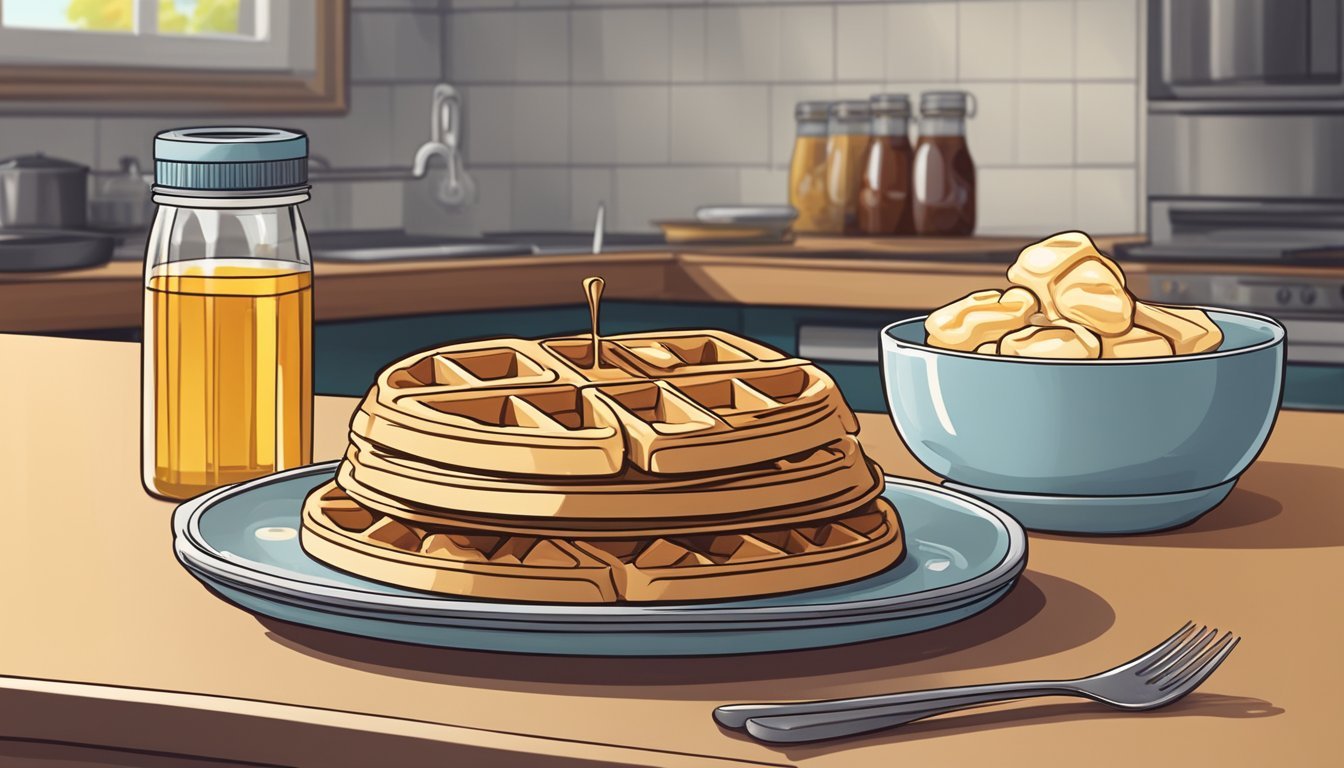How Long Do Freshly Prepared Waffles Last
Shelf Life and Storage Tips
Freshly prepared waffles are a beloved breakfast food across America, known for their crisp edges and fluffy interiors. Whether made from scratch, a dry mix, or purchased in a self-stable package, waffles are typically composed of ingredients like flour and a type of oil or fat. As a freshly cooked item, waffles have a limited shelf life and the storage method plays a crucial role in maintaining their quality.
When fresh waffles cool to room temperature, their shelf life varies depending on the subsequent storage conditions. In the refrigerator, these waffles can remain suitable for consumption for up to three days. This short window ensures that the waffles retain their texture and flavor before there is a noticeable decline in quality.
For longer preservation, freezing is the recommended option. When stored properly in a freezer, fresh waffles can last for up to three months. To achieve this extended shelf life, it's important to store the waffles in an airtight container or tightly wrap them in plastic wrap or aluminum foil to prevent freezer burn. This method of storage not only preserves the waffles for later use but also maintains their textural integrity when reheated.
Understanding Waffle Freshness
The longevity of a waffle's freshness is a balance between its ingredients and storage. Fresh waffles can offer a delightful texture and taste, but certain factors determine how long they retain their peak quality.
Factors Affecting Freshness
Freshness in waffles is contingent upon a few critical variables. First, the composition of ingredients plays a role. Ingredients like sugar and eggs can influence the shelf life; sugar acts as a preservative extending freshness, whereas eggs can limit it due to their perishability.
The storage environment is another crucial aspect. Fresh waffles maintain their crispness best when stored in a dry, cool environment. If they are stored improperly, moisture can seep in and soften their texture, reducing their freshness.
Temperature: Avoid high temperatures that speed up spoilage.
Humidity: Store in low humidity to preserve crispness.
Air Exposure: Minimize air contact with proper sealing.
Identifying Freshness
To ascertain if a waffle is still fresh, one should examine its texture and crispness. A fresh waffle typically has a crispy edge and soft, fluffy center. If the waffles exhibit a soggy or overly hard texture, it may indicate they are past their prime. Freshness also encompasses flavor; a stale taste can signal that the waffles are no longer at their best.
Visual Check: Look for mold or discoloration.
Texture Check: Feel for crispness or sogginess.
Smell Test: Detect any off odors that are indicative of spoilage.
Storing Fresh Waffles
Proper storage of freshly prepared waffles is essential to maintain their quality and extend their shelf life. They can be stored at room temperature, in the refrigerator, or in the freezer.
Room Temperature Storage
Fresh waffles can be kept at room temperature for a short period. They should be cooled to avoid condensation and then placed in an airtight container to keep out moisture and contaminants. Typically, stored this way, waffles last up to two days.
Refrigerator Storage
For longer storage, refrigeration is recommended. Waffles should be wrapped securely in plastic wrap or placed in resealable plastic bags to prevent them from drying out. In the refrigerator, they remain fresh for up to one week.
Freezer Storage
To extend their shelf life even further, waffles can be frozen. They should be wrapped in plastic wrap first and then in aluminum foil, or placed in an airtight container or freezer bag to avoid freezer burn. Stored in the freezer, waffles can last for up to three months. Remember to label the container or bag with the date to keep track of their storage time.
Freezing Waffles
Freezing waffles is an excellent way to extend their shelf life and enjoy them at a later date. Proper freezing keeps waffles fresh and retains their flavor and texture.
How to Freeze Waffles
To freeze waffles:
Cool the waffles completely: Ensure they are at room temperature to prevent moisture buildup which can lead to freezer burn.
Place on a baking sheet: Arrange the waffles in a single layer on a flat baking sheet.
Freeze until solid: This initial freeze prevents waffles from sticking together; about 2 hours.
Transfer to freezer-safe containers: Place the frozen waffles in freezer bags or containers. Separate layers with parchment paper.
Label and date: Mark the containers with the freeze date. Properly frozen waffles maintain quality for up to 3 months but are safe to consume beyond this time.
Important Note: Do not add toppings or spreads before freezing, as this can affect the freezing process and overall quality.
Thawing Process
To thaw frozen waffles:
Refrigerate overnight: Thawing in the refrigerator is preferred for even defrosting.
Use a toaster or microwave: For immediate consumption, frozen waffles can often be reheated directly in a toaster or microwave. Adjust cooking time based on the appliance and waffle thickness.
Remember that once thawed, waffles should be eaten promptly and should not be refrozen to ensure the best taste and texture.
Reheating Stored Waffles
Properly reheating stored waffles can restore their original warmth and crispiness. This section provides three specific methods for reheating waffles that have been previously cooked and stored.
Toaster Method
Using a toaster is an effective way to reheat waffles, especially if they are frozen. The toaster provides a quick and efficient heating process, restoring the waffles’ warmth and crispness.
Steps:
Insert the waffle into the toaster.
Set the toaster to a medium setting.
Reheat until the waffle is thoroughly warm and crisped to preference, typically about one minute.
Oven Method
The oven method is suitable for reheating multiple waffles simultaneously and is capable of evenly distributing heat. Reheating in an oven helps to maintain the desired level of moisture without making the waffles too dry or soggy.
Temperature and Time:
Preheat the oven to 350°F (175°C).
Place the waffles directly on the middle oven rack or on a baking sheet.
Heat for 10-15 minutes. Checking periodically to prevent over-browning.
Microwave Method
The microwave offers the quickest way to reheat waffles, although it's important to avoid over-microwaving, which can lead to a loss of texture.
Tips:
If the waffles are frozen, thaw them slightly before microwaving to ensure even reheating.
Use the microwave in short 30-second bursts to warm the waffles, checking after each interval for desired temperature and moisture.
Remember, when reheating any type of waffle, monitoring is key to avoid ending up with an overcooked or tough texture.
Maintaining Quality and Safety
Proper food storage is crucial for minimizing mold growth and maintaining the texture, crispness, and overall quality of freshly prepared waffles. These aspects can significantly impact how long the waffles remain safe and enjoyable to eat.
Preventing Mold Growth
To prevent mold from developing on waffles, one should store them in a refrigerator within two hours of cooking. Refrigeration slows down mold growth and extends the waffles’ shelf life. For optimal results, waffles should be kept in:
An airtight container or a resealable bag.
A refrigerator set at or below 40°F (4°C).
This approach prevents exposure to air, which not only reduces the risk of mold but also preserves freshness.
Preserving Texture and Flavor
Preserving the crispness and flavor of waffles involves protecting them from moisture and temperature fluctuations. Here are steps to maintain their quality:
Cool waffles to room temperature before refrigerating to prevent condensation.
Wrap waffles individually with plastic wrap or aluminum foil to maintain their texture.
For extended storage, place waffles in a single layer in a freezer-safe bag or container, separating layers with parchment paper to prevent sticking.
Stored in the freezer, waffles can maintain quality for up to three months. When reheating, using a toaster or oven can help restore the waffles' original crispness and warmth, making them nearly as good as freshly prepared ones.
Convenience and Meal Prep
Incorporating freshly prepared waffles into meal planning can provide both convenience and nutrition, especially when leveraging the benefits of freezing. Proper storage techniques are key to maintaining the quality of waffles for later use.
Meal Planning with Waffles
One can integrate waffles into meal planning by preparing them in large batches and then freezing. This approach offers the advantage of having a ready-to-eat breakfast or snack without daily preparation time. When storing waffles in the freezer, it is important to:
Wrap the waffles individually or in pairs in plastic wrap to prevent freezer burn.
Place the wrapped waffles in an airtight freezer bag or container to hinder moisture loss.
Label the container with the date to keep track of freshness, ensuring they are consumed within the optimal time frame of up to 3 months.
This method ensures waffles retain their texture and taste upon reheating, making them indistinguishable from freshly cooked ones.
Benefits of Pre-Preparation
Pre-preparing waffles and storing them conveniently in the freezer provides a variety of benefits:
Saves time: Having waffles ready to eat reduces morning stress and allows for more time to be spent on other activities.
Reduces food waste: Freezing waffles when they are at peak freshness helps avoid spoilage and excessive food waste.
Accessibility: Individuals with busy lifestyles can benefit significantly from having pre-packaged frozen waffles, providing a quick and easy meal solution.
By employing efficient meal prep strategies, freshly prepared waffles can serve as a dependable staple in one's diet, minimizing effort without compromising on quality.
Waffles as a Breakfast Staple
Waffles have cemented their status as a quintessential breakfast food both in America and Belgium, cherished for their versatility and delightful taste.
Popularity in America and Belgium
In America, waffles are synonymous with a hearty breakfast. They serve not just as a weekend luxury but also as a quick weekday morning meal. Belgian waffles, distinguished by their larger size and deeper pockets, have become especially popular in the United States after being introduced at the 1964 New York World's Fair. In Belgium, waffles are deeply rooted in the country's culinary tradition, with different regions boasting their unique waffle styles that are often enjoyed throughout the day.
Waffle Varieties
There are several variations of waffles that highlight their status as a beloved breakfast staple:
American Waffles: Typically denser and thinner than their Belgian counterparts, these are often enjoyed with syrup, butter, and a side of breakfast meats.
Belgian Waffles: Known for their lighter batter, larger squares, and deeper pockets, perfect for holding more toppings, such as fresh fruit, chocolate, whipped cream, or ice cream.
Other varieties showcase the adaptability of waffles across different cuisines and taste preferences, reinforcing their place as a breakfast staple globally.
Additional Tips and Tricks
When it comes to ensuring the longevity and quality of waffles, the approaches one takes during cooking and storage are vital. Here are specific techniques to optimize waffle-making and batter preservation.
Optimal Cooking Techniques
Cooking Waffles Evenly: For the best results, preheat your waffle iron until it's hot. This ensures a crispy exterior while keeping the inside fluffy. Once poured, the waffle batter should spread to cover the grids. Don’t Open the Iron Too Early; this causes waffles to split and lose their perfect texture.
Baking Powder: Freshness is key for waffles to rise properly. Confirm that your baking powder is not expired to guarantee ideal fluffiness.
Cooling: Place cooked waffles on a wire rack instead of stacking them. This prevents steam from making them soggy, hence prolonging their crispness.
Storing Leftover Batter
Airtight Containers: If they have leftover batter, one should store it in an airtight container to prevent oxidation and contamination.
Refrigeration: Batter can be kept in the refrigerator for 1-2 days. Keep in mind that the leavening agent, such as baking powder, may lose efficacy over time, possibly affecting the waffle's texture upon subsequent uses.
Conclusion
Freshly prepared waffles are a delightful treat, but their shelf life is limited. They should be consumed within three days when stored in the refrigerator. To extend their life, one may freeze them, where they can remain in good quality for up to three months.
When freezing, it’s critical that the waffles are cooled and placed in an airtight container to prevent freezer burn and preserve their overall quality. Here's a quick reference guide:
Refrigerator Storage: Up to 3 days
Freezer Storage: Up to 3 months
Signs of spoilage include an off smell, discoloration, and mold. If any of these signs are present, the waffles should be discarded immediately.
For the best eating experience, reheating should be done in a toaster or oven to maintain the crispness that defines a good waffle. Microwaving can lead to a softer, less desirable texture.
In summary, while freshly prepared waffles have a limited shelf life at room temperature or in the fridge, proper storage techniques can significantly extend their enjoyment window, allowing one to savor their homemade delights well beyond their initial preparation.











